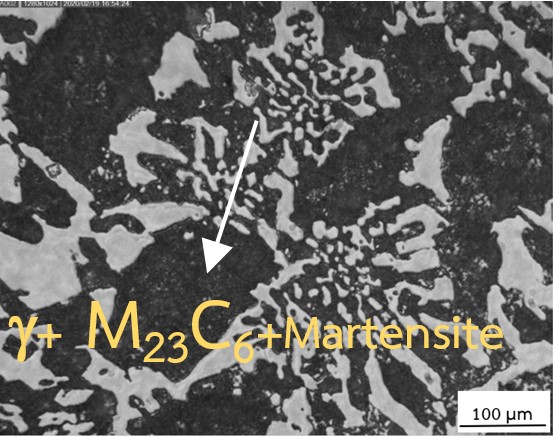ผลของการเชื่อมและการทำกรรมวิธีทางความร้อนที่ส่งผลต่อความแข็งของเหล็กหล่อโครเมียมสูง
Main Article Content
บทคัดย่อ
เหล็กหล่อโครเมียมสูงถูกใช้งานภายใต้สภาวะที่มีการสึกหรอสูงเกิดการแตกหักบ่อยครั้ง ความเสียหายนี้ส่งผลต่อต้นทุนการผลิต ซึ่งการเชื่อมซ่อมแซมสามารถลดต้นทุนการผลิตได้ การเชื่อมต้องใช้ตัวแปรในการเชื่อมที่เหมาะสมเพื่อให้ได้คุณสมบัติเหมาะกับการใช้งาน งานวิจัยนี้ศึกษาผลของการเชื่อม การชุบแข็งและการอบคืนตัวต่อความแข็งของเหล็กหล่อโครเมียมสูงเพื่อเป็นแนวทางในการเชื่อมซ่อมบำรุง ปัจจัยในการศึกษาคือ การเชื่อม การชุบแข็งและการอบคืนตัว ชิ้นทดลองถูกนำไปอบอ่อนที่อุณหภูมิ 950 องศาเซลเซียส เป็นเวลา 5 ชั่วโมง จากนั้นเชื่อมชิ้นทดลองด้วยลวดเชื่อม Ni 98 ชิ้นงานเชื่อมถูกอบที่อุณหภูมิ 1,050 องศาเซลเซียส 1 ชั่วโมง 30 นาที ชุบแข็งในน้ำมัน ชิ้นงานที่ผ่านการชุบแข็งถูกอบคืนตัวที่อุณหภูมิ 525 องศาเซลเซียส 1 ชั่วโมง จากนั้นวัดความแข็งด้วยเครื่องทดสอบแบบร็อคเวล 3 บริเวณ คือ บริเวณโลหะเชื่อม บริเวณผลกระทบจากความร้อนและบริเวณโลหะพื้น ทำการวิเคราะห์ข้อมูลทางสถิติ ผลการทดลองพบว่าบริเวณโลหะเชื่อมทั้งสามกระบวนการมีค่าความแข็งไม่แตกต่างกัน ส่วนบริเวณผลกระทบจากความร้อนและบริเวณโลหะพื้นนั้นการชุบแข็งและการอบคืนตัวส่งผลให้บริเวณผลกระทบจากความร้อนและบริเวณโลหะพื้นมีค่าความแข็งสูงกว่าบริเวณโลหะเชื่อม บริเวณโลหะพื้นมีค่าความแข็งสูงสุด คือ 63 HRC การวิเคราะห์สถิติพบว่าค่าความแข็งแตกต่างกันอย่างมีนัยสำคัญทางสถิติ 0.05 การเชื่อมเหล็กหล่อโครเมียมสูงและการทำกรรมวิธีทางความร้อนส่งผลต่อการเพิ่มค่าความแข็งบริเวณโลหะพื้น จากการเกิดคาร์ไบด์ลำดับที่สองและมาร์เทนไชต์ ในการเลือกใช้ลวดเชื่อม Ni 98 ปริมาณนิเกิลในลวดเชื่อมที่สูงส่งผลให้ออสเทนไนต์มีความเสถียรภาพสูง ซึ่งลดโอกาสการเกิดมาร์เทนไชต์ส่งผลให้ค่าความแข็งโลหะเชื่อมต่ำกว่าโลหะพื้น
Article Details

อนุญาตภายใต้เงื่อนไข Creative Commons Attribution-NonCommercial-NoDerivatives 4.0 International License.
บทความที่ได้รับการตีพิมพ์ในวารสารฯ ท้ังในรูปแบบของรูปเล่มและอิเล็กทรอนิกส์เป็นลิขสิทธิ์ของวารสารฯ
เอกสารอ้างอิง
P. Kosasu and S. Inthidech, “Effect of silicon on hardness during heat treatment of 16%Cr cast iron with 2%Mo,” in the 13th Mahasarakham University Research Conference, P. Prathepha, Ed. Mahasarakham, Thailand, Sep. 7-8, 2017, pp. 90-95. (in Thai)
M. Filipovic, Ž. Kamberovic, M. Korac and B. Jordovic, “Effect of Niobium and Vanadium additions on the As-Cast microstructure and properties of hypoeutectic Fe-Cr-C Alloy,” ISIJ International, vol. 53, no. 12, pp. 2160-2166, Jan. 2013.
C. Scandian, C. Boher, J. D. B. de Mello and F. Rézaï-Aria, “Effect of molybdenum and chromium contents in sliding wear of high-chromium white cast iron: The relationship between microstructure and wear,” Wear, vol. 267, no. 1-4, pp. 401-408, Jun. 2009
P. Sokawe, S. Inthidech and K. Sriprateep, “Effect of cryogenic treatment on variation of hardness during subcritical heat treatment of 16 wt% Cr-2 wt% Mo cast iron with Vanadium,” Journal of Science and Technology Mahasarakham University, vol. 33, no. 1, pp. 13-18. Feb. 2014. (in Thai)
S. Inthidech, K. Boonmak, P. Sricharoenchai, N. Sasaguri and Y. Matsubara, “Effect of repeated tempering on hardness and retained austenite of high Chromium cast iron containing Molybdenum,” Materials Transactions, vol. 51, no. 7, pp. 1264-1271, Jun. 2010.
P. Kosasu, S. Inthidech, P. Sricharoenchai and Y. Matsubara, “Effect of Silicon on subcritical heat treatment behavior and wear resistance of 16 wt% Cr Cast Iron with 2 wt% M,” Journal of Metals, Materials and Minerals, vol. 22, no. 2, pp. 89-95, 2012.
R. K. Bhatnagar and G. Gupta, “A review on weldability of cast iron,” International Journal of Scientific & Engineering Research, vol. 7, no. 5, pp. 126-131, May. 2016.
T. Teker and E. M. Karakurt, “Friction welding of high chromium white cast iron and AISI1030 steel couple with nickel interlayer,” in UDCS' Fourth International Iron and Steel Symposium, M. Yasar, Ed. Karabuk, Turkey, Apr. 4-6, 2019, pp. 26-28.
P. Batkhuu, G. Omoontsoo, B. Lygdenov, and A. Guriev, “Laser processing of high chromium white iron,” Journal of physics: Conference series, vol. 2131, no. 5, Dec. 2021.
A. Cruz-Crespo, R. Fernández-Fuentes, A. V. Ferraressi, R. A. Gonçalves and A. Scotti, “Microstructure and abrasion resistance of Fe-Cr-C and Fe-Cr-C-Nb hardfacing alloys deposited by S-FCAW and cold solid wires,” Soldagem & Inspeção, vol. 21, no. 3, pp. 342–353, Sep. 2016.
H. Wang and S. Yu, “Influence of heat treatment on microstructure and sliding wear resistance of high chromium cast iron electroslag hardfacing layer,” Surface and Coatings Technology, vol. 319, pp. 182–190, Jun. 2017.
A O’Brien and C. Guzman, Welding Handbook, Volume 4: Material and Application, Part 1, 9th ed. Miami, FL, USA: American Welding Society, 2011.
M. Sangsuriyan and P. Surin, “Study of microstructure and creep resistance of electrical welding process in spheroidal graphite cast-iron,” EAU Heritage Journal Science and Technology, vol. 13, no. 1, pp. 197-208. Apr. 2019. (in Thai)
S. Noyming, W. Homjabok and N. Thammachot, “Analysis of factors affecting the case depth hardness of hardened surface in low carbon steel by design of experiments using limestone as an energizer in pack carburizing process,” Journal of Industrial Technology Ubon Ratchathani Rajabhat University, vol. 11, no. 2, pp. 67-80. Dec. 2020. (in Thai)
E. S. V. Marques, F. J. G. Silva, O. C. Paiva and A. B. Pereira, “Improving the mechanical strength of ductile cast iron welded joints using different heat treatments,” Materials, vol. 12, no. 14, Jul. 2019, Art. no. 2263.
Z. Guo, F. Xiao, S. Lu, H. Li and B. Liao, “Effects of heat-treatment on the microstructure and wear resistance of a High-chromium cast iron for rolls,” Advances in Materials Science and Engineering, vol. 2016, Oct. 2016, Art. no. 9807685.
S. Inthidech, P. Sricharoenchai and Y. Matsubara, “Effect of alloying elements on heat treatment behavior of hypoeutectic high Chromium cast iron,” Materials Transactions, vol. 47, no. 1, pp. 72–81, Jan. 2006.


